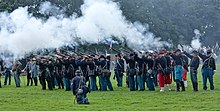Our website is made possible by displaying online advertisements to our visitors.
Please consider supporting us by disabling your ad blocker.
Gunpowder



Gunpowder, also commonly known as black powder to distinguish it from modern smokeless powder, is the earliest known chemical explosive. It consists of a mixture of sulfur, charcoal (which is mostly carbon), and potassium nitrate (saltpeter). The sulfur and charcoal act as fuels while the saltpeter is an oxidizer.[1][2] Gunpowder has been widely used as a propellant in firearms, artillery, rocketry, and pyrotechnics, including use as a blasting agent for explosives in quarrying, mining, building pipelines, tunnels,[3] and roads.
Gunpowder is classified as a low explosive because of its relatively slow decomposition rate, low ignition temperature and consequently low brisance (breaking/shattering). Low explosives deflagrate (i.e., burn at subsonic speeds), whereas high explosives detonate, producing a supersonic shockwave. Ignition of gunpowder packed behind a projectile generates enough pressure to force the shot from the muzzle at high speed, but usually not enough force to rupture the gun barrel. It thus makes a good propellant but is less suitable for shattering rock or fortifications with its low-yield explosive power. Nonetheless, it was widely used to fill fused artillery shells (and used in mining and civil engineering projects) until the second half of the 19th century, when the first high explosives were put into use.
Gunpowder is one of the Four Great Inventions of China.[4] Originally developed by Taoists for medicinal purposes, it was first used for warfare around AD 904.[5] Its use in weapons has declined due to smokeless powder replacing it, whilst its relative inefficiency led to newer alternatives such as dynamite and ammonium nitrate/fuel oil replacing it in industrial applications.[6]
- ^ Agrawal 2010, p. 69.
- ^ Cressy 2013.
- ^ James, Susan (15 April 2020). "A history of tunneling and underground construction and the factors driving current and future demand". Graduate Programs. Retrieved 21 September 2023.
- ^ Buchanan (2006), p. 42
- ^ Andrade 2016, p. 31.
- ^ Rossotti, Hazel (2002). Fire: Servant, Scourge, and Enigma. Courier Dover Publications. pp. 132–37. ISBN 978-0-486-42261-9.
Previous Page Next Page


